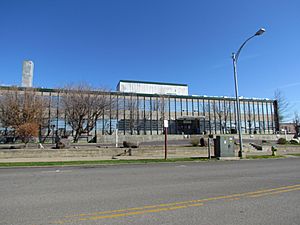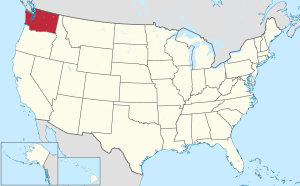Kittitas County, Washington facts for kids
Quick facts for kids
Kittitas County
|
||
|---|---|---|

Kittitas County Courthouse in Ellensburg
|
||
|
||

Location within the U.S. state of Washington
|
||
 Washington's location within the U.S. |
||
| Country | ||
| State | ||
| Founded | November 24, 1883 | |
| Seat | Ellensburg | |
| Largest city | Ellensburg | |
| Area | ||
| • Total | 2,333 sq mi (6,040 km2) | |
| • Land | 2,297 sq mi (5,950 km2) | |
| • Water | 36 sq mi (90 km2) 1.5%% | |
| Population
(2020)
|
||
| • Total | 44,337 | |
| • Estimate
(2023)
|
45,508 |
|
| • Density | 20/sq mi (8/km2) | |
| Time zone | UTC−8 (Pacific) | |
| • Summer (DST) | UTC−7 (PDT) | |
| Congressional district | 8th | |
Kittitas County is a county located in the state of Washington. In 2020, about 44,337 people lived there. The main city and county seat is Ellensburg. The county was created in November 1883. It was formed from part of Yakima County. Kittitas County is also home to the Ellensburg, Washington, Micropolitan Statistical Area.
The name "Kittitas" comes from the language of the Yakama Nation. There are many ideas about what the name means. Some say it means 'white chalk' or 'shale rock'. Others believe it means 'shoal people' or 'land of plenty'. Experts agree that all these meanings might be true. It depends on the specific dialect spoken.
Contents
History of Kittitas County
Kittitas County was officially set up in November 1883. This happened when the Washington Territorial Legislature created it. The new county was formed from the northern part of Yakima County.
For hundreds of years, the lands along the Yakima River were home to native peoples. These groups were known as the Kittitas, or Upper Yakima. The Kittitas Valley was a special meeting place for tribes. These tribes lived east of the Cascade Mountains.
White settlers started moving into the Kittitas Valley in the late 1850s. Their arrival led to changes for the native people. The original inhabitants were eventually moved to the Yakama Indian Reservation. The new settlers brought new ways of life. They started raising livestock and growing crops. Dairying, logging, and mining also became important.
The county had lots of grassland and good land. This made raising beef and cattle a main activity. Railways came to the area, which helped with trade. Large-scale irrigation systems were also built in the 1930s. These systems helped farmers water their crops.
Wheat farming in Kittitas Valley began in 1868. The first flour mill was built near Ellensburg in 1873. Growing alfalfa was also important from the county's early days.
Logging was a big activity, especially in the western part of the county. Logging camps were set up near the three largest lakes. These lakes are Cle Elum, Kachess, and Keechelus. Mining for coal and other minerals started in the mid-1880s.
A part of the southeastern corner of the county is used by the U.S. Army. It is called the Yakima Training Center.
Geography of Kittitas County
Kittitas County covers a total area of about 2,333 square miles. Most of this is land, about 2,297 square miles. The rest, about 36 square miles (1.5%), is water. The highest point in the county is Mount Daniel. It stands at 7,959 feet above sea level.
Key Geographic Features
Major Roads and Highways
 Interstate 90
Interstate 90 Interstate 82
Interstate 82 U.S. Route 97
U.S. Route 97
Neighboring Counties
- Chelan County - to the north
- Douglas County - to the northeast
- Grant County - to the east
- Yakima County - to the south
- Pierce County - to the west
- King County - to the northwest
Protected Natural Areas
- Snoqualmie National Forest (part of it is in the county)
- Wenatchee National Forest (part of it is in the county)
Plants and Animals
Kittitas County is home to many different kinds of plants and animals. You can find various grasses, herbs, and trees here. There are also many types of birds, mammals, and amphibians. One of the first grasses identified in the county was Oryzopsis, a type of ricegrass.
Among the amphibians, you might find the Cascades frog. The rough-skinned newt is also common. This newt is found across the western USA. Some newts in the county have shown a special trait called neoteny. This means they keep their larval features even as adults.
Population and People
| Historical population | |||
|---|---|---|---|
| Census | Pop. | %± | |
| 1890 | 8,777 | — | |
| 1900 | 9,704 | 10.6% | |
| 1910 | 18,561 | 91.3% | |
| 1920 | 17,737 | −4.4% | |
| 1930 | 18,154 | 2.4% | |
| 1940 | 20,230 | 11.4% | |
| 1950 | 22,235 | 9.9% | |
| 1960 | 20,467 | −8.0% | |
| 1970 | 25,039 | 22.3% | |
| 1980 | 24,877 | −0.6% | |
| 1990 | 26,725 | 7.4% | |
| 2000 | 33,362 | 24.8% | |
| 2010 | 40,915 | 22.6% | |
| 2020 | 44,337 | 8.4% | |
| 2023 (est.) | 45,508 | 11.2% | |
| U.S. Decennial Census 1790–1960 1900–1990 1990–2000 2010–2020 |
|||
In 2010, there were 40,915 people living in Kittitas County. There were 16,595 households. The population density was about 17.8 people per square mile. Most people (89.3%) were white. Other groups included Asian (2.0%), American Indian (1.0%), and Black or African American (0.9%). About 7.6% of the population was of Hispanic or Latino origin.
The average age of people in the county was 31.9 years. About 24.1% of households had children under 18 living with them.
Communities in Kittitas County
Cities
- Cle Elum
- Ellensburg (This is the county seat)
- Kittitas
- Roslyn
Town
Ghost Towns
Census-Designated Places
Unincorporated Communities
Events and Festivals
The Kittitas County Fair and the Ellensburg Rodeo are big events. They happen every year during Labor Day Weekend. The Kittitas County Fair started in 1885. It moved to its current spot in Ellensburg in 1923.
See also
 In Spanish: Condado de Kittitas para niños
In Spanish: Condado de Kittitas para niños



